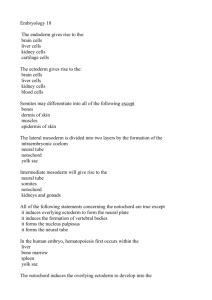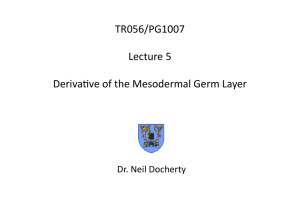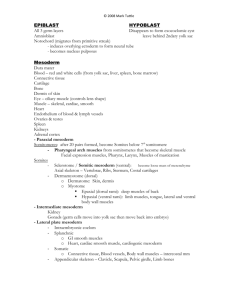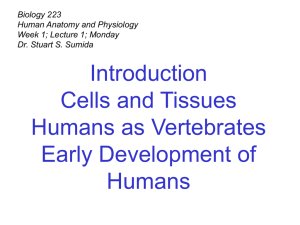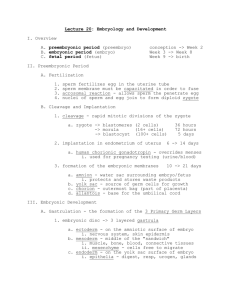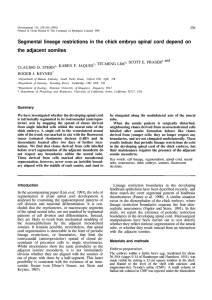PPT
advertisement
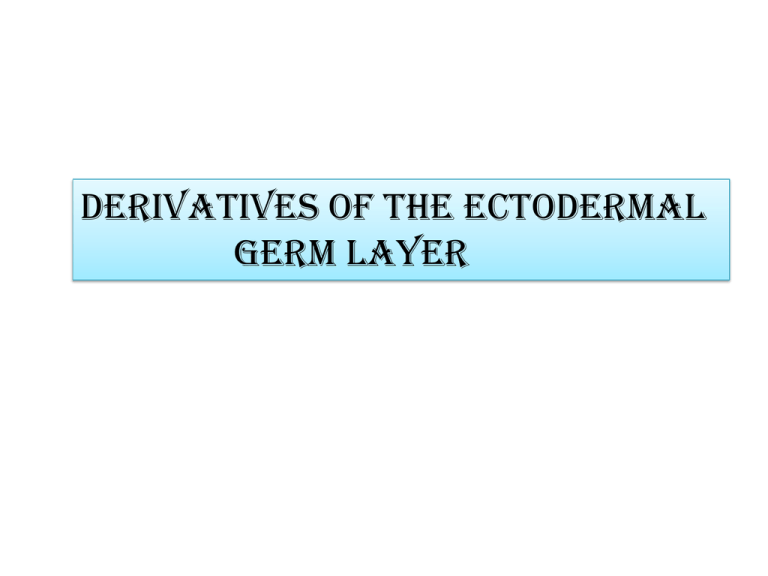
Derivatives of the ectodermal germ layer Development of the neural tube At the middle of the epiblast another swelling called 1- neural plate appears The neural plate replaces the receding primitive streak and closes the pore formed before By the end of the third week, the lateral edges of the neural plate become more elevated to form neural folds the depressed midregion forms the 2-Neural groove Gradually, the neural folds approach each other in the midline, where they fuse and form: 3-Neural tube Fusion begins in the cervical region (fifth somite) and proceeds cranially and caudally As a result the neural tube is formed. Until fusion is complete the cephalic and caudal ends of the neural tube communicate with the amniotic cavity by way of the cranial and caudal neuropores Parts of the neural tube 1-neural crest 2-alar plate 3-basal plate alar plate basal plate The nervous system is formed from the ectoderm (the neural tube) The neural crest gives rise to the ganglia The alar plate gives rise to the sensory part of the nervous system The basal plate gives rise to the motor system part of the nervous Neural crest Cells at the lateral border or crest of the neuroectoderm begin to dissociate from their neighbors AND undergo an epithelial-to-mesenchymal transition as it leaves the neuroectoderm by active migration and displacement to enter the underlying mesoderm NEURAL CREST cells migrate along one of two pathways: 1) a dorsal pathway through the dermis, where they will enter the ectoderm to form melanocytes In the skin and hair follicles 2) a ventral pathway through the anterior half of each somite to become sensory ganglia, sympathetic and enteric neurons , Schwann cells, and cells of the adrenal medulla Neural crest cells also form and migrate from cranial neural folds, leaving the neural tube before closure in this region These cells contribute to the craniofacial skeleton as well as neurons for cranial ganglia Neural Crest Derivatives 1-Connective tissue and bones of the face and skull 2-Cranial nerve ganglia 3-C cells of the thyroid gland 4-Conotruncal septum in the heart 5- Odontoblasts 6-Dermis in face and neck 7-Spinal (dorsal root) ganglia 8-Sympathetic chain and preaortic ganglia 9-Parasympathetic ganglia of the gastrointestinal tract 10-Adrenal medulla 11-Schwann cells 12-Glial cells 13-Arachnoid and pia mater (leptomeninges) 14-Melanocytes In general terms, the ectodermal germ layer gives rise to organs and structures that maintain contact with the outside world: (a) the central nervous (b) the peripheral nervous system c) the sensory epithelium of the ear, nose, and eye (d) the epidermis, including the hair and nails In addition, it gives rise to subcutaneous glands, the mammary glands, the pituitary gland, and enamel of the teeth. The notochord gives rise to the Nucleus pulpous Of the intervertebral disk Derivatives of the mesodermal germ layer Paraxial mesoderm It develops into TWO PERIPHERAL MASSES and a constriction in the middle Called: 1-Medail mesoderm 2-Intermediate mesoderm 3-lateral mesoderm Medial mesoderm •The medial mesoderm enlarges pushing the ectoderm upwards to give the As the embryo develops the number of the somites Increases from one to reach about 44-45 somites when the embryo is completely developed About 10 somites vanish when the tail of the embryo is lost somites The first pair of somites arises in the occipital region of the embryo at approximately the 20th day of development From here, new somites appear in craniocaudal sequence at a rate of approximately three pairs per day until the end of the fifth week, There are: four occipital eight cervical 12 thoracic five lumbar five sacral, and eight to 10 coccygeal pairs. The first occipital and the last five to seven coccygeal somites later disappear WHAT IS THE destiny OF EACH SOMITE? By the beginning of the fourth week cells forming the ventral and medial walls of the somite lose their compact organization, and shift their position to surround the notochord These cells, collectively known as THE SCLEROTOME They will surround the spinal cord and notochord to form the vertebral column Cells at the dorsolateral portion of the somite also migrate as precursors of the limb and body wall musculature (hypomeric) musculature After migration of these muscle cells and cells of the sclerotome, Cells at the dorsomedial portion of the somite proliferate and migrate to form a new layer THE MYOTOME myotome contributes to muscles of the back (epaxial musculature) or epimeric musculature the extensor muscles of the vertebral column The remaining dorsal epithelium forms the dermatome dermatomes form the dermis and subcutaneous tissue of the skin a transversal section through the embryo at level A is displayed. The somites have released themselves and form dermatomes, myotomes and sclerotomes. Dermatome Myotome Sclerotome Derivatives of the intermediate mesoderm It gives off: 1- Urine performing tubule (Kidney and ureter) 2-internal genitalia in males and femals (part of it not all) WHY the embryo folds? 1- Extensive and rapid growth of the cranial end of the neural tube 2- The faster growth of the axial part of the embryonic disc than its periphery 3- Enlargement of the amnion Folding of the embryo Cephalocaudally and Laterally Head (cephalic) fold Tail (caudal) fold The embryonic disc begins to bulge into the amniotic cavity and to fold Cephalocaudally Folding of the embryo Cephalocaudally Folding of the embryo Laterally WEEK 4 EMBRYO Primordia of the brain General features Somites Branchial arches Primordia of the heart Primordia of the eye Upper limbs bud Primordia of the nose Primordia of the liver Lower limbs bud Derivatives of the lateral mesoderm Lateral mesoderm splits into two layers: 1- Parietal (somatic) 2- Visceral (splanchnic) Mesoderm from the parietal layer, together with overlying ectoderm, forms the lateral body wall folds These folds, together with the head (cephalic) and tail (caudal) folds, close the ventral body wall 1-The parietal layer of lateral mesoderm forms: A) The dermis of the skin in the body wall and limbs B) The bones and connective tissue of the limbs C) The sternum D) Mesoderm cells of the parietal layer surrounding the intraembryonic cavity form thin membranes, the mesothelial membranes, or serous membranes, which will line the 1-peritoneal 2- pleural 3- pericardial cavities E) In addition, sclerotome and muscle precursor cells that migrate into the parietal layer of lateral plate mesoderm form the costal cartilages, limb muscles, and most of the body wall muscles 2-The visceral layer of lateral mesoderm Surrounds the primitive gut and together with embryonic endoderm, forms THE WALL OF THE GUT TUBE Mesoderm also gives rise to the vascular system, that is, the heart, arteries, veins, lymph vessels, and all blood and lymph cells DERIVATIVES OF THE ENDODERMAL GERM LAYER The gastrointestinal tract is the main organ system derived from the endodermal germ layer With development the embryonic disc begins to bulge into the amniotic cavity and to fold cephalocaudally and Lateral folds also form and move ventrally to assist in body wall closure As a result of cephalocaudal folding, a continuously larger portion of the endodermal germ layer is incorporated into the body of the embryo to form the gut tube. The midgut communicates with the yolk sac by way of a broad stalk the VITELLINE DUCT The tube is divided into three regions: FOREGUT MIDGUT HINDGUT The midgut remains in communication with the yolk sac. Initially, this connection is wide but as a result of body folding, it gradually becomes long and narrow to form the vitelline duct Only much later, when the vitelline duct is obliterated, does the midgut lose its connection with the original endoderm-lined cavity and obtain its free position in the abdominal cavity At its cephalic end, the foregut is temporarily bounded by an ectodermal-endodermal (no mesoderm) membrane called the OROPHARYNGEAL membrane This membrane separates the stomadeum,(the primitive oral cavity derived from ectoderm), from the pharynx, (a part of the foregut derived from endoderm). In the fourth week, the oropharngeal membrane ruptures, establishing an open connection between the oral cavity and the primitive gut The hindgut also terminates temporarily at an ectodermal-endodermal membrane, THE CLOACAL membrane This membrane separates the upper part of the anal canal (derived from endoderm), from the lower part called (the proctoderm) that is formed by an invaginating pit lined by ectoderm. The membrane breaks down in the seventh week to create the opening for the anus No mesoderm Buccopharyngeal membrane Why? Cloacal membrane As a result of folding from the head, tail, and two lateral body wall folds The ventral body wall of the embryo is closed except for a small part in the umbilical region where the yolk sac duct and connecting stalk are attached. ENDODERM GIVES RISE TO: •The epithelial lining of the respiratory tract •The parenchyma of the thyroid, parathyroids, liver, and pancreas •The reticular stroma of the tonsils and thymus •The epithelial lining of the urinary bladder and urethra •The epithelial lining of the tympanic cavity and auditory tube
